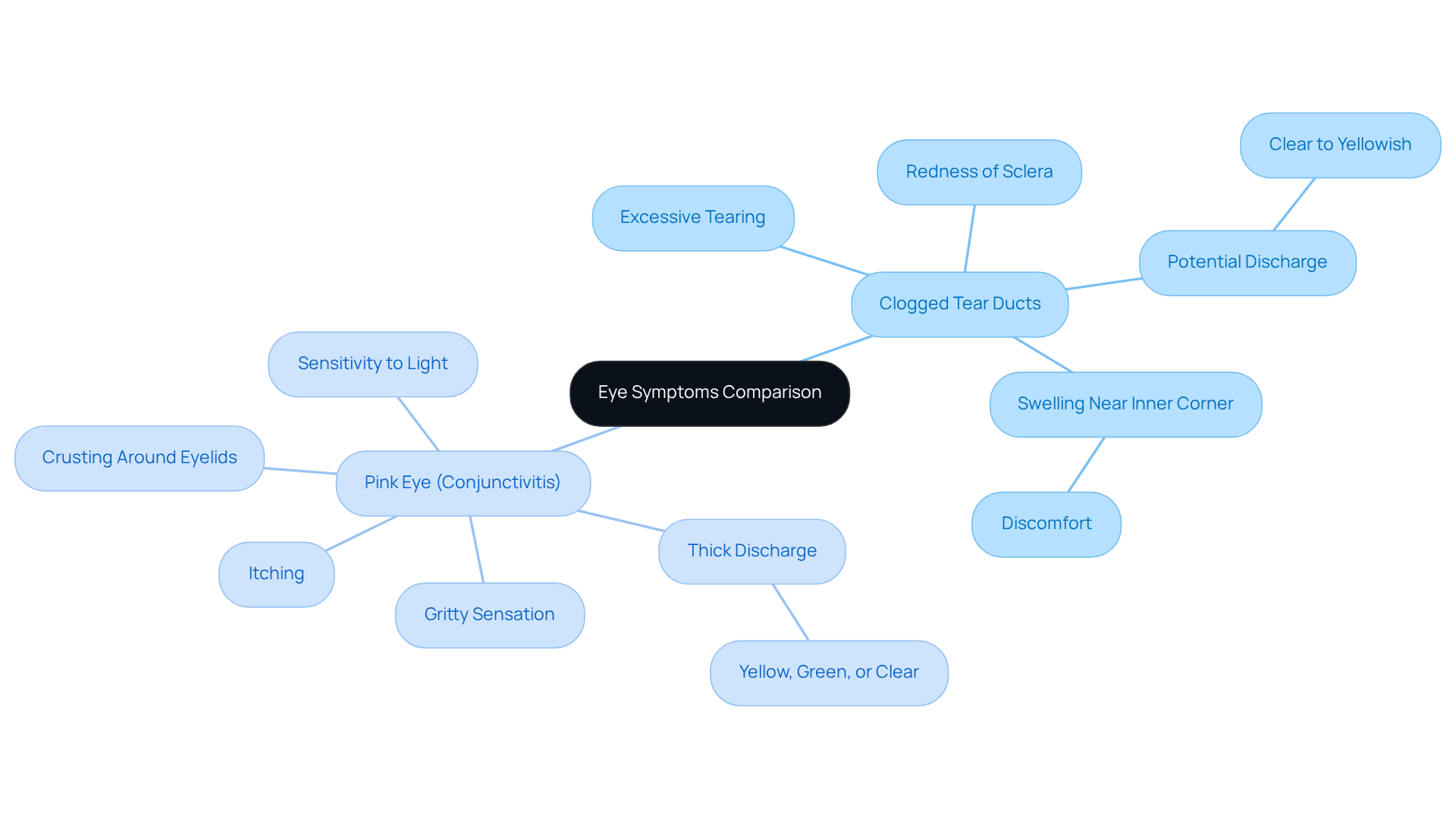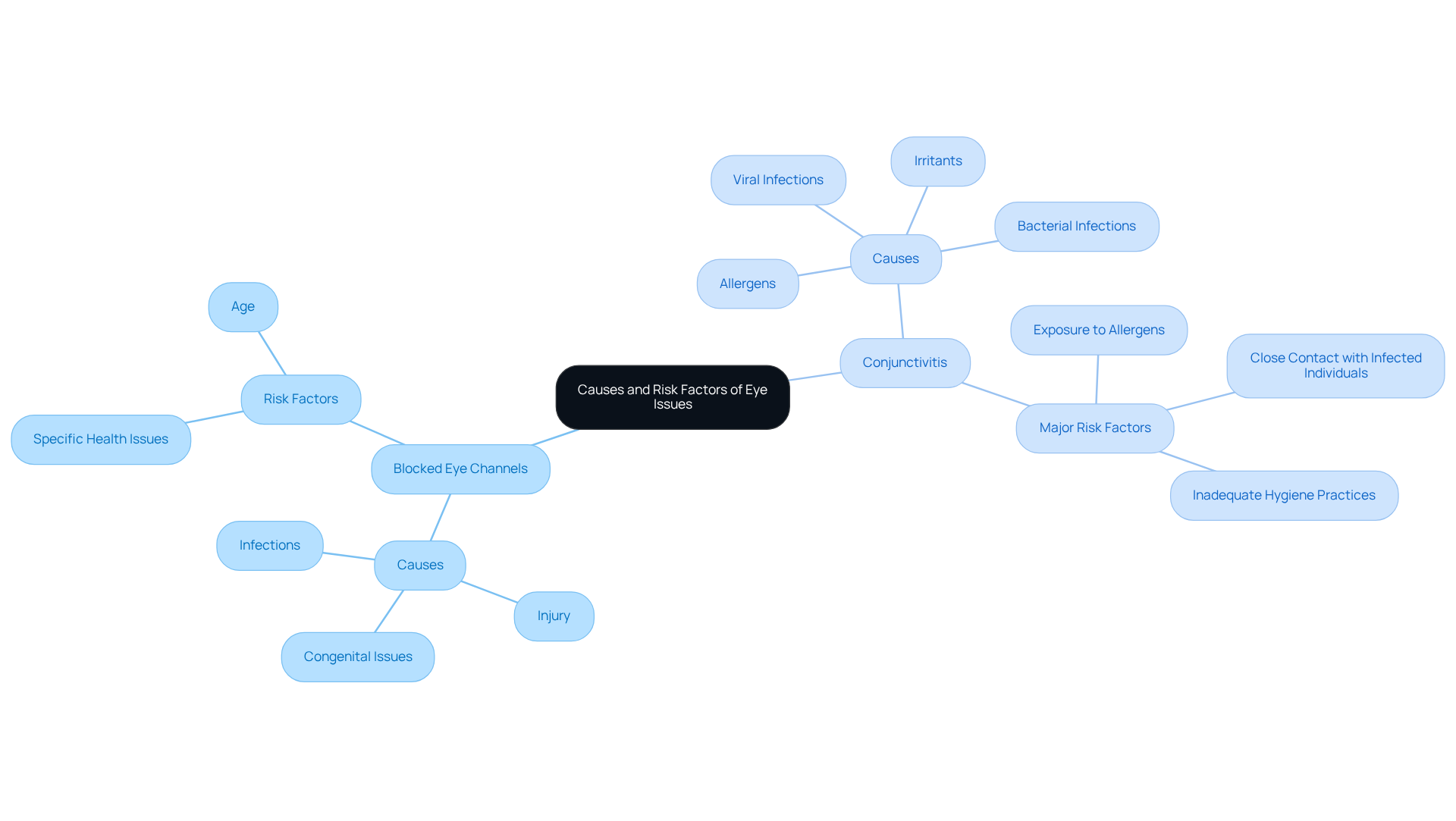Posted by: Northwest Eye in General on July 3, 2025
Overview
Understanding the differences between clogged tear ducts and pink eye is important for your peace of mind. Clogged tear ducts occur when there is an obstruction in the drainage system, leading to excessive tearing and discomfort. We understand that this can be frustrating and uncomfortable.
On the other hand, pink eye, or conjunctivitis, is an inflammation often caused by infections or allergens. It is characterized by pronounced redness and discharge. Knowing the distinctions between these conditions can help you feel more in control of your health.
Each condition requires different management strategies, and we are here to help you navigate your options. It’s common to feel overwhelmed, but remember that seeking care can lead to relief and reassurance.
Introduction
Understanding the nuances of eye health is crucial, especially when faced with common yet distinct conditions like clogged tear ducts and pink eye. We understand that experiencing these issues can be concerning. While both conditions can lead to watery eyes, the underlying causes, symptoms, and treatments vary significantly. This article delves into the key differences between these two conditions, exploring what you can expect and how to effectively manage them.
It’s common to feel uncertain about what to do when the lines between these two eye issues blur. How can you distinguish between them for appropriate care? We are here to help you through this process.
Understanding Clogged Tear Ducts and Pink Eye
, also known as nasolacrimal duct obstruction, can be concerning for many. This condition occurs when the fluid drainage system is obstructed, which can prevent moisture from draining effectively. As a result, you may experience excessive tearing, discomfort, and an increased risk of infections due to stagnant tears. Common symptoms include redness, recurrent eye infections, and painful swelling near the inner corner of the eye.
In contrast, eye inflammation, or conjunctivitis, is an irritation of the conjunctiva. This condition is usually triggered by infections—whether viral or bacterial—as well as allergies or irritants. While both clogged tear duct vs pink eye can result in watery eyes, their underlying causes and implications differ significantly. It’s important to note that blocked eye channels are not infectious, whereas conjunctivitis can spread quickly, especially in its viral and bacterial forms.
Recent studies suggest that the incidence of is approximately 30.5 per 100,000 population, underscoring the prevalence of this condition. We understand how overwhelming it can feel to navigate these issues. Effective management of conjunctivitis often involves understanding its causes and applying preventive measures, like practicing proper hygiene and avoiding irritants.
By recognizing the distinct characteristics of these conditions, you can seek the appropriate treatment and care. Remember, we are here to help you through this process, providing support and guidance every step of the way.
Comparing Symptoms: Clogged Tear Ducts vs. Pink Eye
We understand that experiencing symptoms related to your eyes can be concerning. When comparing clogged tear duct vs pink eye, symptoms of clogged tear ducts often include:
- Excessive tearing
- Redness of the sclera (the white part of the eye)
- Potential discharge that can range from clear to yellowish
- Swelling near the inner corner of your eye, which can be uncomfortable
In contrast, ocular inflammation, or conjunctivitis, is characterized by pronounced redness and swelling of the conjunctiva, which often leads to discussions about clogged tear duct vs pink eye. This condition may come with:
- Itching
- A gritty sensation
- A thick discharge that can be yellow, green, or clear
While both clogged tear duct vs pink eye can result in watery eyes, it’s common to see notable redness and the presence of a thick discharge more typically associated with conjunctivitis.
Further symptoms of conjunctivitis may encompass:
- Sensitivity to light
- Crusting around the eyelids, especially in instances triggered by bacterial infections
We want you to know that recent studies indicate the success rate for resolving symptoms of pink eye in adults is approximately 77%. This highlights the importance of timely diagnosis and treatment.
Understanding the differences in symptoms is crucial for effective management and intervention in cases of clogged tear duct vs pink eye. Remember, we are here to help you through this process and provide the support you need.

Causes and Risk Factors
Blocked eye channels can arise from congenital issues, injury, or infections that cause scarring. We understand that this condition can be particularly concerning for parents, especially since it is common in babies. Studies show that over 5% of all newborns are impacted by eye drainage blockage at birth, and between 6% and 20% encounter some type of eye drainage obstruction. Risk factors for blocked eye channels include age and specific health issues that hinder fluid production. It’s common to feel worried if your little one experiences watery or ‘mattery’ eyes, as this could indicate a clogged tear duct vs pink eye, which can also lead to symptoms of conjunctivitis.
Notably, blocked tear ducts can contribute to failed pediatric vision tests, as they may be associated with amblyopia and refractive errors if left untreated. In contrast, eye inflammation, or conjunctivitis, can arise from various sources, including:
- viral infections (such as adenovirus)
- bacterial infections (like staphylococcus)
- allergens (such as pollen)
- irritants (including smoke or chlorine)
We recognize that understanding these causes can help alleviate some concerns.
Major risk factors for conjunctivitis include:
- close contact with infected individuals
- inadequate hygiene practices
- exposure to allergens
It’s important to note that approximately 135 in every 10,000 individuals are affected by pink eye annually, leading to an estimated loss of 3 million school days each year, with $589 million spent on pink eye treatment in the US. Understanding these causes and risk factors is crucial for effective prevention and management of both clogged tear duct vs pink eye conditions.
Furthermore, conjunctivitis resulting from a blocked eye channel can happen in infants, and most nasolacrimal channel obstructions resolve naturally during the first year of life. We want to reassure you that for 10-12 days, so being aware of this can help in managing the situation. We are here to help you through this process and provide the support you need.

Treatment Options
Treatment for blocked ducts typically starts with gentle, conservative methods like warm compresses and soft massage, aimed at encouraging drainage. We understand that this can be frustrating, and if these approaches do not yield results, more invasive options such as probing or dacryocystorhinostomy may be necessary to restore normal tear flow. It’s reassuring to know that studies indicate an overall clinical success rate of around 89% for endoscopic dacryocystorhinostomies, highlighting a strong likelihood of effective treatment for those facing chronic issues.
In contrast, the treatment for ocular inflammation can vary widely based on its underlying cause. For instance:
- Viral conjunctivitis often resolves on its own.
- Bacterial conjunctivitis typically requires antibiotic eye drops for effective management.
- Allergic conjunctivitis can usually be managed with antihistamines and by steering clear of known allergens.
As wisely notes, “Greater flap mobility and greater lacrimal sac marsupialization in endonasal DCR are associated with better rates of early anatomical patency,” underscoring the importance of personalized treatment strategies.
Looking ahead to 2025, we are excited about the emergence of new treatments for pink eye, including advanced topical therapies that effectively target specific pathogens. Understanding the right treatment for conditions like clogged tear duct vs pink eye is crucial for effective management and recovery. Remember, timely intervention can significantly enhance patient outcomes, and we are here to help you through this process.
Conclusion
Understanding the distinctions between clogged tear ducts and pink eye is essential for effective diagnosis and treatment. We know that both conditions may present with similar symptoms, such as watery eyes, which can be confusing. However, their underlying causes and implications are markedly different. Clogged tear ducts result from obstructions in the fluid drainage system, leading to excessive tearing and discomfort. In contrast, pink eye, or conjunctivitis, is an inflammatory condition often caused by infections or allergens.
This article delves into key differences, highlighting symptoms unique to each condition. Clogged tear ducts typically manifest as excessive tearing and swelling near the inner eye. On the other hand, pink eye is characterized by pronounced redness, itching, and a thick discharge. Understanding the causes and risk factors associated with each condition is critical, especially for parents concerned about their children’s eye health. Treatment options vary significantly; clogged tear ducts often require conservative approaches like warm compresses, while pink eye may necessitate antibiotics or antihistamines depending on the cause.
Ultimately, recognizing the differences between clogged tear ducts and pink eye empowers you to seek appropriate care and treatment. Awareness of symptoms, causes, and treatment options can lead to better health outcomes and reduce anxiety related to eye conditions. If you or your child is experiencing eye discomfort, we understand that consulting a healthcare professional is crucial for a proper diagnosis and tailored treatment plan. We are here to help you through this process, ensuring that both conditions are effectively managed.
Frequently Asked Questions
What are clogged tear ducts, and what causes them?
Clogged tear ducts, or nasolacrimal duct obstruction, occur when the fluid drainage system is blocked, preventing moisture from draining effectively. This can lead to excessive tearing, discomfort, and an increased risk of infections due to stagnant tears.
What are the common symptoms of clogged tear ducts?
Common symptoms include excessive tearing, redness, recurrent eye infections, and painful swelling near the inner corner of the eye.
What is pink eye, and what causes it?
Pink eye, or conjunctivitis, is an inflammation of the conjunctiva, often triggered by infections (viral or bacterial), allergies, or irritants.
How do clogged tear ducts and pink eye differ in terms of contagion?
Clogged tear ducts are not infectious, while pink eye can spread quickly, especially in its viral and bacterial forms.
What is the prevalence of symptomatic acquired lacrimal obstruction?
Recent studies indicate that the incidence of symptomatic acquired lacrimal obstruction is approximately 30.5 per 100,000 population.
How can conjunctivitis be effectively managed?
Effective management of conjunctivitis often involves understanding its causes and applying preventive measures, such as practicing proper hygiene and avoiding irritants.
Why is it important to recognize the differences between clogged tear ducts and pink eye?
Recognizing the distinct characteristics of these conditions helps in seeking the appropriate treatment and care for each condition.






